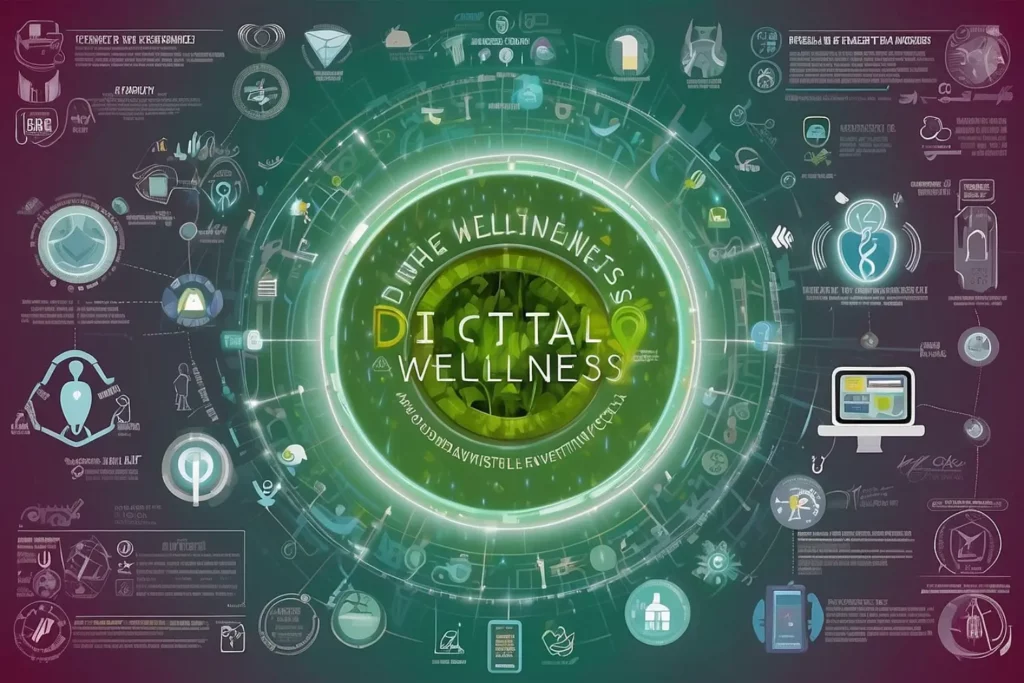
As our fingers tap on screens more than ever, it’s easy to feel overwhelmed by the digital world. Digital wellness is key to keeping our minds and bodies happy in this tech-driven age.
Our blog offers practical steps to regain control and create a harmony between clicks and real-life moments. Dive in for a happier, healthier you!
Key Takeaways
- Digital wellbeing is crucial for maintaining a healthy balance between online activities and real-world experiences, promoting mental and physical health.
- To combat digital overload, it’s important to set specific device-free times, create tech-free zones, and engage in mindfulness practices.
- Employing technology in moderation can support healthy habits such as fitness tracking, sleep monitoring, and mindful breathing exercises.
- Building a community and establishing workplace policies that prioritise digital wellbeing can lead to improved employee well-being and productivity.
- Individuals share the responsibility with companies to embrace digital wellbeing by setting goals and boundaries around technology use.
Understanding Digital Wellness
Digital Wellness focuses on maintaining a healthy relationship with technology to promote mental, emotional, and physical health in a hyperconnected world. It is important because it helps individuals manage their information and screen time effectively while prioritising their overall well-being.
What is Digital Wellness?
Digital wellness is about striking the right balance between our online and offline worlds. It means using technology in a way that supports our mental, emotional, and physical health without letting it take over our lives.
Think of it as your tech-life harmony—knowing when to log on for work or fun and understanding when it’s time to switch off for some real-world experiences.
Every day we make choices about how we use our devices; digital wellness encourages us to make those choices intentionally. For parents juggling screen time for kids, office workers glued to computers all day, or anyone scrolling through social media at night, embracing this concept can lead to better sleep, less stress, and more quality family time.
Let’s explore why digital wellness matters next.
Why is it Important?
Maintaining digital wellness is crucial in today’s tech-savvy world. A healthy relationship with technology supports physical and mental wellbeing, enabling individuals to navigate the online realm confidently while prioritising self-care.
Recognising the impact of emerging technologies on personal and professional life highlights the significance of integrating intentional technology usage into daily routines.
Understanding digital wellness involves acknowledging both its advantages and potential pitfalls. With an intentional approach to technology use, individuals can foster a balanced lifestyle that promotes overall wellbeing.
Embracing digital wellness is a proactive step towards mitigating the adverse effects of excessive screen time and information overload.
The Impact of Emerging Technologies
The rapid advancement of digital technologies has revolutionised the way we live and work, but it also comes with a downside. Digital overload can result in increased stress, decreased productivity, and negative impacts on mental health.
Understanding these consequences is crucial for finding a balance between benefiting from technology and avoiding its drawbacks.
The Double-Edged Sword of Digitalisation
The widespread use of digital technology has revolutionised the way we live and work, offering numerous benefits for communication, learning, and productivity. However, it also brings potential downsides that can affect our physical and mental health if not managed carefully.
Digitalisation provides convenience and efficiency but can lead to symptoms of digital overload such as eye strain, poor posture, decreased physical activity, and increased stress.
Moreover, excessive screen time or reliance on digital devices may contribute to mental health issues like anxiety and depression. Finding a healthy balance in the use of digital tools is crucial to mitigate these negative impacts.
Symptoms of Digital Overload
Digital overload can have various symptoms that indicate an unhealthy relationship with technology. These may include:
- Persistent headaches and eyestrain due to excessive screen time, which can lead to digital eye strain and other vision-related issues.
- Difficulty concentrating or staying focused on tasks, as constant exposure to digital devices can impact cognitive function.
- Increased irritability or mood swings, often stemming from the stress and anxiety caused by being constantly connected.
- Disrupted sleep patterns, such as insomnia or poor-quality sleep, which may result from late-night use of digital devices.
- Physical discomfort in the neck, shoulders, and back due to poor posture while using digital devices for extended periods.
- Decreased physical activity levels and sedentary behaviour resulting from excessive time spent on screens.
Strategies for Promoting Digital Wellness
Designating device-free time and setting clear goals and priorities can help individuals maintain a healthy balance with technology. Improving work habits and boundaries is also essential for promoting digital wellness in the era of emerging technologies.
Designating Device-Free Time
Intentionally setting aside device-free time is crucial for promoting digital wellbeing. It allows for mental and physical recharge, improved focus, and increased presence in real-life experiences.
- Establish specific times each day, such as mealtimes or before bed, to disconnect from devices and engage in offline activities or social interactions.
- Create device-free zones within the home or workplace, such as the dining area or meeting rooms, to encourage offline interactions and reduce screen time.
- Utilise technology tools, like apps or built-in features, that allow for setting automatic device downtime during specific hours to limit usage.
- Encourage family members or colleagues to join in on designated tech-free activities, fostering a supportive environment for unplugging and connecting face-to-face.
- Plan outdoor excursions or hobbies that naturally necessitate leaving devices behind, promoting a healthy balance between screen time and physical activities.
Setting Goals and Priorities

To maintain digital wellness, it is crucial to set clear goals and establish priorities in your technology use. Here are some strategies to help you achieve this:
- Establish specific and achievable goals that align with your values and overall wellbeing. Consider the impact of technology on different aspects of your life, such as work, relationships, and leisure.
- Prioritise activities that promote mental and physical health, such as exercise, spending quality time with loved ones, and engaging in hobbies or creative pursuits.
- Create a balanced schedule that includes designated device-free time for relaxation, mindfulness practices, or pursuing offline activities.
- Reflect on your digital habits and identify areas where you can make positive changes to better align with your goals and priorities.
- Practice mindful technology usage by focusing on tasks that align with your priorities rather than mindlessly scrolling through social media or engaging in excessive screen time.
- Set boundaries around technology use at work by prioritising tasks, minimising distractions, and establishing clear guidelines for when to disconnect from work-related devices.
- Regularly assess your progress towards achieving your digital wellness goals and adjust them as needed to ensure they remain relevant and beneficial to your overall wellbeing.
- Seek support from friends, family members, or colleagues who can help hold you accountable for maintaining healthy digital habits aligned with your goals and priorities.
Improving Work Habits and Boundaries
Improving work habits and setting boundaries is crucial for maintaining digital wellness. Here are some strategies to help achieve a healthy balance:
- Establish specific work hours and stick to them, ensuring that there is a clear separation between work and personal time.
- Take regular breaks during the workday to re-energise and avoid prolonged screen exposure, which can lead to digital fatigue.
- Prioritise tasks and set realistic goals to minimise the risk of feeling overwhelmed by constant digital demands.
- Communicate openly with colleagues about expectations for communication outside of working hours to establish clear boundaries.
- Create a designated workspace free from distractions, promoting focus and productivity while working online.
- Practise mindfulness techniques during work hours to stay present and reduce stress associated with digital multitasking.
- Set aside tech-free time before bed to unwind and improve sleep quality by minimising exposure to stimulating screens.
- Incorporate physical activity into the daily routine to counteract sedentary behaviours often associated with prolonged technology use.
The Role of Technology in Digital Wellness

Utilising technology for healthy habits and mindfulness practices can help individuals find balance in their digital lives. It is important to incorporate technology as a tool for promoting wellness rather than allowing it to become a source of stress and overuse.
Digital Detoxing and Mindfulness Practices
Cultivating digital wellness involves intentional and balanced use of technology to promote overall wellbeing. Digital detoxing and mindfulness practices play a crucial role in achieving this balance by helping individuals recalibrate their relationship with technology. Here are some ways to incorporate digital detoxing and mindfulness practices into your daily routine:
- Start by designating specific times each day or week for tech-free activities such as reading, exercising, or spending time with loved ones.
- Practice mindfulness through meditation, deep breathing exercises, or simply taking a few minutes to be fully present in the moment without any digital distractions.
- Engage in outdoor activities that allow you to disconnect from screens and reconnect with nature, such as hiking, gardening, or simply enjoying a walk in the park.
- Create boundaries around your technology usage, such as turning off notifications during designated offline periods or setting limits on screen time.
- Consider participating in digital detox challenges or retreats that encourage complete disconnection from technology for a set period of time to reset and recharge.
Utilising Technology for Healthy Habits
Integrating technology for healthy habits enhances overall wellness. Using apps and devices to track fitness, monitor sleep patterns, and manage stress can promote a balanced lifestyle.
Employing reminders and alerts from technology can assist in maintaining regular exercise routines and hydration levels. By harnessing the potential of digital tools, individuals can cultivate healthy habits that support their physical and mental wellbeing.
Embracing technology responsibly is necessary for promoting healthy habits in today’s digital age. Utilising tech tools such as meditation apps, mindful breathing exercises, or even simply setting screen time limits on devices fosters a healthier relationship with technology.
The Importance of Community and Support
Creating a supportive community is crucial for cultivating digital wellness. By connecting with others who share similar goals, individuals can find encouragement and accountability in their efforts to maintain a healthy relationship with technology.
Sharing experiences, challenges, and successes within a community fosters a sense of camaraderie and understanding, reducing feelings of isolation often associated with digital overload.
Utilising support networks also provides access to diverse perspectives and strategies for managing technology use effectively.
Moreover, workplaces play an important role in promoting digital wellness through supportive environments. Organisations can encourage open discussions about healthy tech habits, provide resources for employees to learn about digital wellbeing, and offer flexible policies that prioritise employee health over constant connectivity.
Embracing a Balanced Digital Life

Taking collective responsibility for finding a healthy balance with technology and embracing digital wellness to improve physical and mental health.
Find out how you can achieve this by reading the full blog post!
The Collective Responsibility of Individuals and Companies
Individuals and companies share the collective responsibility of promoting digital wellness. Embracing a healthy balance between technology use and offline activities is essential.
Individuals can prioritise self-care by setting boundaries on their digital consumption, while companies can create supportive environments that encourage employees to disconnect when necessary.
Additionally, organisations can provide resources for managing technology usage and promote mental wellbeing through policies that support work-life balance.
The Benefits of Digital Wellness
Digital wellness offers numerous benefits for individuals striving to maintain a healthy relationship with technology. Embracing digital wellness can lead to improved mental and physical health, allowing individuals to mitigate the negative impacts of excessive screen time.
By integrating intentional technology usage into their daily routines, people can enhance their overall wellbeing, finding an optimal balance between online activities and real-world experiences.
Furthermore, fostering digital wellness can contribute to heightened productivity, better sleep quality, and enhanced relationships both at work and home.
Recognising the advantages of digital wellness empowers individuals in making informed decisions about their technology use. It also provides opportunities for creating healthier habits and boundaries that support long-term health and happiness.
Cultivating digital wellness is essential for maintaining a healthy balance in today’s digital era. It involves intentional and balanced technology usage to promote overall wellbeing. Companies must recognise the significance of digital wellness, ensuring employee physical and mental health while individuals should prioritise setting goals and boundaries to achieve a harmonious relationship with technology.
Finding balance between life online and offline is crucial for fostering a positive connection with emerging technologies, helping to avoid potential consequences of overusing them.
In an era of emerging technologies, understanding the impact of tech use on physical and mental health is key to proactively finding balance. Balancing work habits and personal time can contribute significantly to maintaining a healthy lifestyle. Embracing strategies such as: designating device-free time, practising mindfulness, integrating tech for healthy habits, and seeking community support will aid in promoting digital wellness across all spheres of life – personal or professional.
